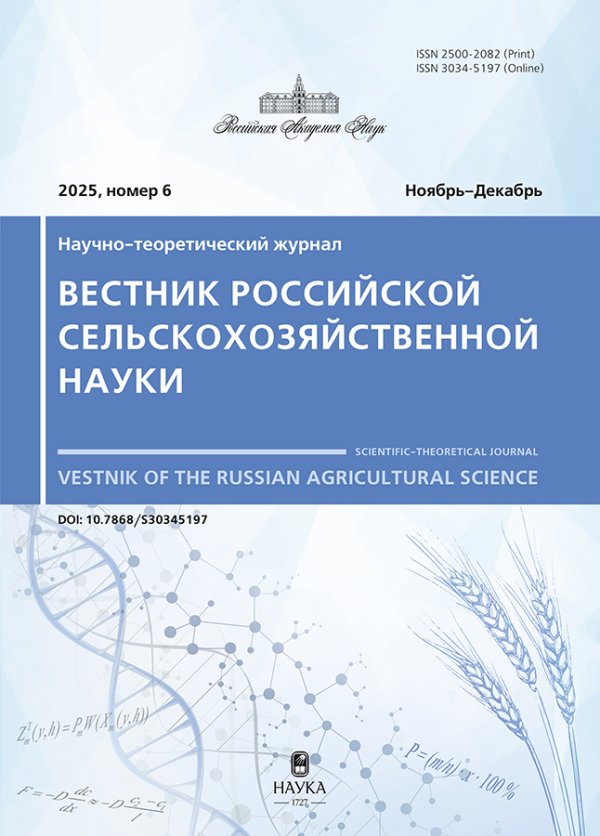Адаптивные свойства перспективных сортообразцов сои в условиях рязанской области по признаку «сбор белка с единицы площади»
- Авторы: Гуреева Е.В.1, Солодягина А.В.1
-
Учреждения:
- Институт семеноводства и агротехнологий – филиал ФГБНУ «Федеральный научный агроинженерный центр ВИМ»
- Выпуск: № 2 (2025)
- Страницы: 16-20
- Раздел: Растениеводство и селекция
- URL: https://journal-vniispk.ru/2500-2082/article/view/293745
- DOI: https://doi.org/10.31857/S2500208225020041
- EDN: https://elibrary.ru/HUMBBF
- ID: 293745
Цитировать
Аннотация
Исследования проводили в 2021–2023 годах в Институте семеноводства и агротехнологий (ИСА – филиал ФГБНУ ФНАЦ ВИМ), расположенном в Рязанской области. Уровень адаптивных свойств перспективных сортообразцов сои оценивали по признаку «сбор белка с единицы площади» общепринятыми методами. Почва опытного участка – темно-серая лесная тяжелосуглинистая, содержание органического вещества – 4,95%, подвижного фосфора – 213 мг/кг почвы, подвижного калия – 155 мг/ кг почвы, общего азота – 0,228%, рНсол. – 4,91 ед. Установлено, что среднее содержание белка в семенах варьировало от 37,0 до 42,8%, у стандарта – 40,2%, сбор белка за период исследований – 750 кг/га. Слабую вариабельность показателя «сбор белка с единицы площади» наблюдали у сортообразцов Н-25/17, Н-7/17, Н-19/17 и Н-32/17 (V = 6,7–9,7%). Для определения адаптивности сорта использовали коэффициент отзывчивости на условия внешней среды – от 1,12 (Н-25/17) до 2,02 (Н-9/17). Линии Н-19/17 и Н-25/17 обладают высокой генетической гибкостью и имеют слабую вариабельность показателя «сбора белка с единицы площади» – 8,7 (Н-19/17) и 6,7% (Н-25/17).
Ключевые слова
Полный текст
Об авторах
Елена Васильевна Гуреева
Институт семеноводства и агротехнологий – филиал ФГБНУ «Федеральный научный агроинженерный центр ВИМ»
Автор, ответственный за переписку.
Email: elenagureeva@bk.ru
Кандидат сельскохозяйственных наук, ведущий научный сотрудник
Россия, с. Подвязье, Рязанская обл.Анна Викторовна Солодягина
Институт семеноводства и агротехнологий – филиал ФГБНУ «Федеральный научный агроинженерный центр ВИМ»
Email: elenagureeva@bk.ru
Младший научный сотрудник
Россия, с. Подвязье, Рязанская обл.Список литературы
- Арькова Ж.А., Манаенков К.А., Колдин М.С. и др. Эффективность борьбы с сорняками в посевах сои на территории Тамбовской области // Технологии пищевой и перерабатывающей промышленности АПК – продукты здорового питания. 2017. № 4 (18). С. 15–20.
- Гончаренко А.А. Об адаптивности и экологической устойчивости сортов зерновых культур. Вестник РАСХН. 2005. № 6. С. 49–53.
- Грязнов А.А. Карабалыкский ячмень. Кустанай: Из-во: Печат. двор, 1996. 448 с.
- Гуреева Е.В., Солодягина А.В. Оценка сортов сои мировой коллекции в условиях Центрального Нечерноземья по признаку «масса семян с одного растения» // Зерновое хозяйство России. 2024. Т. 16. № 2. С. 62–66. https://doi.org/10.31367/2079-8725-2024-91-2-62-66
- Доспехов Б.А. Методика полевого опыта (с основами статистической обработки результатов исследований). 5-е изд., перераб. и доп. М.: Альянс, 2014. 352 с.
- Животков Л.А., Морозова З.А., Секатуева Л.И. Методика выявления потенциальной продуктивности и адаптивности сортов и селекционных форм озимой пшеницы по показателю урожайности // Селекция и семеноводство. 1994. № 2. С. 3–6.
- Зубарева К.Ю., Бобков С.В., Хрыкина Т.А. Влияние органоминеральных микроудобрений на накопление белка в органах растений и качество зерна сои // Зернобобовые и крупяные культуры. 2022. № 2 (42). С. 5–15. https://doi.org/10.24412/2309-348X-2022-2-5-15
- Зыкин В.А., Белан И.А., Юсов В.С., Корнева С.П. Методика расчета параметров экологической пластичности сельскохозяйственных растений по дисциплине «Экологическая генетика». Омск, 2008. 36 с.
- Сидорова Е.К., Федосеева В.В. Эффективное увеличение производственных посевов под соей в Орловской области, обладающими высоким процентным содержанием белка и жира в соевых бобах // Вестник аграрной науки. 2023. № 1(100). С. 154–160.
- Филимонов Я.И., Коцарева Н.В. Повышение белка сои агротехническими приемами // Вестник Курской государственной сельскохозяйственной академии. 2023. № 2. С. 18–21.
- Юсова О.А., Николаев П.Н., Васюкевич В.С. и др. Уровень качества зерна омских сортов овса ярового в контрастных экологических условиях // Вестник НГАУ. 2020. № 2 (55). С. 84–96. https://doi.org/10.31677/2072-6724-2020-55-2-84-96
- Gureeva E.V., Levakova O.V. Remote monitoring of chlorophyll content in soybean crops in the conditions of the Ryazan region // BIO Web of Conferences. 2023. 71. 01090. https://doi.org/10.1051/bioconf/20237101090
- Jiang H., Egli D.B. Soybean seed number and crop growth rate during flowering // Agronomy Journal. 1995. Vol. 87. PP. 264–267.












